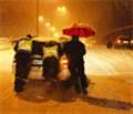AAA Offers Advice on How to Go in Ice and Snow
 |
Go In Snow AWD
DEARBORN, Mich., Feb. 1, 2008 -- Winter weather conditions can affect your car's handling and braking ability. Slow down, keep your distance and increase the chances you'll arrive at your destination safely.
AAA suggests the following winter-driving suggestions:
-- Increase your following distance. Build in a six-second time gap. Pick
a marker or sign and begin counting when the car ahead passes it --
"one-thousand-one, one-thousand-two..."
-- Exercise caution. Ice is most likely to form first and be slipperiest
in shaded areas, bridges, overpasses and intersections.
-- Improve visibility. Clear snow and ice from the entire car. Brush away
snow from the hood, roof, trunk, turn signals, lights, windows,
mirrors, and fender wells.
-- Drive with headlights on low-beam. Lights at low-beam provide better
road illumination in snow and fog than do high-beams.
-- Slow down in bad weather. Remember, posted speed limits are set for
ideal road and weather conditions.
-- Avoid sudden starts, stops and turns. Accelerate carefully so car
wheels don't spin.
-- Apply brakes firmly. The best technique for braking on ice or snow is
"threshold" or "squeeze" braking. Apply brakes firmly to a point just
short of lock-up and ease off the brake pedal slightly.
-- Steady pressure is better than "pumping" the brakes. For anti-lock
brakes, continuous firm braking is recommended. Refer to your owner's
manual for proper procedure.
-- In a skid, ease off the accelerator. Carefully steer in the direction
you want the car to go and straighten the wheel as soon as the car
begins to go in the desired direction.
-- Anticipate danger. Be on the lookout for ice on bridges, snow-covered
lane markings, stalled cars and poor visibility. Watch for drivers who
are unprepared for changing road conditions.


